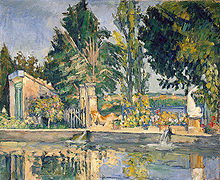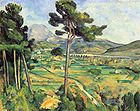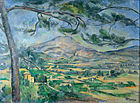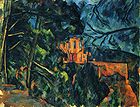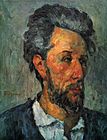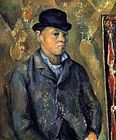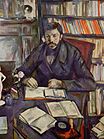- Paul Cézanne
-
Paul Cézanne 
Paul Cézanne, c. 1861Born 19 January 1839
Aix-en-Provence, FranceDied 22 October 1906 (aged 67)
Aix-en-Provence, FranceNationality French Field Painting Training Académie Suisse Movement Post-Impressionism Works Mont Sainte-Victoire seen from Bellevue (c. 1885)
Apothéose de Delacroix (1890–1894)
Rideau, Cruchon et Compotier (1893–1894)
The Card Players (1890-1895)
The Bathers (1898–1905)Influenced by Eugène Delacroix, Edouard Manet, Camille Pissarro Influenced Georges Braque, Henri Matisse, Pablo Picasso, Bohumír Dvorský Paul Cézanne (US: /seɪˈzæn/, UK: /sɨˈzæn/, French: [pɔl sezan]; 1839–1906) was a French artist and Post-Impressionist painter whose work laid the foundations of the transition from the 19th century conception of artistic endeavour to a new and radically different world of art in the 20th century. Cézanne can be said to form the bridge between late 19th century Impressionism and the early 20th century's new line of artistic enquiry, Cubism. The line attributed to both Matisse and Picasso that Cézanne "is the father of us all" cannot be easily dismissed.
Cézanne's work demonstrates a mastery of design, colour, tone, composition and draughtsmanship. His often repetitive, sensitive and exploratory brushstrokes are highly characteristic and clearly recognizable. He used planes of colour and small brushstrokes that build up to form complex fields, at once both a direct expression of the sensations of the observing eye and an abstraction from observed nature. The paintings convey Cézanne's intense study of his subjects, a searching gaze and a dogged struggle to deal with the complexity of human visual perception.
Contents
Life and work
Early years and family
The Cézannes came from the small town of Cesana now in West Piedmont, and it has been assumed that their name came from Italian origin.[1] Paul Cézanne was born on 19 January 1839 in Aix-en-Provence, in Provence in the South of France.[2] On 22 February, Paul was baptized in the parish church, with his grandmother and uncle Louis as godparents.[2] His father, Louis-Auguste Cézanne (28 July 1798 – 23 October 1869),[3] was the co-founder of a banking firm that prospered throughout the artist's life, affording him financial security that was unavailable to most of his contemporaries and eventually resulting in a large inheritance.[4]
On the other hand, his mother, Anne Elisabeth Honorine Aubert (24 September 1814 – 25 October 1897),[5] was vivacious and romantic, but quick to take offence.[6] It was from her that Paul got his conception and vision of life.[6] He also had two younger sisters, Marie and Rose, with whom he went to a primary school every day.[2][7]
At the age of ten Paul entered the Saint Joseph school, where he studied drawing under Joseph Gibert, a Spanish monk, in Aix.[7][8] In 1852 Cézanne entered the Collège Bourbon (now Collège Mignet), where he met and became friends with Émile Zola, who was in a less advanced class,[4][7] as well as Baptistin Baille—three friends who would come to be known as "les trois inséparables" (the three inseparables).[9] He stayed there for six years, though in the last two years he was a day scholar.[10] From 1859 to 1861, complying with his father's wishes, Cézanne attended the law school of the University of Aix, while also receiving drawing lessons.[11]
Going against the objections of his banker father, he committed himself to pursuing his artistic development and left Aix for Paris in 1861. He was strongly encouraged to make this decision by Zola, who was already living in the capital at the time. Eventually, his father reconciled with Cézanne and supported his choice of career. Cézanne later received an inheritance of 400,000 francs (£218,363.62) from his father, which rid him of all financial worries.[12]
Cézanne the artist
In Paris, Cézanne met the Impressionist Camille Pissarro. Initially the friendship formed in the mid-1860s between Pissarro and Cézanne was that of master and disciple, in which Pissarro exerted a formative influence on the younger artist. Over the course of the following decade their landscape painting excursions together, in Louveciennes and Pontoise, led to a collaborative working relationship between equals.
Cézanne's early work is often concerned with the figure in the landscape and includes many paintings of groups of large, heavy figures in the landscape, imaginatively painted. Later in his career, he became more interested in working from direct observation and gradually developed a light, airy painting style that was to influence the Impressionists enormously. Nevertheless, in Cézanne's mature work we see the development of a solidified, almost architectural style of painting. Throughout his life he struggled to develop an authentic observation of the seen world by the most accurate method of representing it in paint that he could find. To this end, he structurally ordered whatever he perceived into simple forms and colour planes. His statement "I want to make of impressionism something solid and lasting like the art in the museums",[13] and his contention that he was recreating Poussin "after nature" underscored his desire to unite observation of nature with the permanence of classical composition.
Optical phenomena
Cézanne was interested in the simplification of naturally occurring forms to their geometric essentials; he wanted to "treat nature by the cylinder, the sphere, the cone" (a tree trunk may be conceived of as a cylinder, an apple or orange a sphere, for example). Additionally, the concentrated attention with which he recorded his observations of nature resulted in a profound exploration of binocular vision, which results in two slightly different simultaneous visual perceptions, and provides us with depth perception and a complex knowledge of spatial relationships.
We see two different views simultaneously; Cézanne employed this aspect of visual perception in his painting to varying degrees. The observation of this fact, coupled with Cézanne's desire to capture the truth of his own perception, often compelled him to render the outlines of forms so as to attempt to display the distinctly different views of both the left and right eyes. Thus Cézanne's work augments and transforms earlier ideals of perspective, in particular single-point perspective.
Exhibitions and subjects
Cézanne's paintings were shown in the first exhibition of the Salon des Refusés in 1863, which displayed works not accepted by the jury of the official Paris Salon. The Salon rejected Cézanne's submissions every year from 1864 to 1869. He continued to submit works to the Salon until 1882. In that year, through the intervention of fellow artist Antoine Guillemet, he exhibited Portrait of Louis-Auguste Cézanne, Father of the Artist, reading 'l'Evénement', 1866 (National Gallery of Art, Washington, D.C.), his first and last successful submission to the Salon.[14]
Before 1895 Cézanne exhibited twice with the Impressionists (at the first Impressionist exhibition in 1874 and the third Impressionist exhibition in 1877). In later years a few individual paintings were shown at various venues, until 1895, when the Parisian dealer, Ambroise Vollard, gave the artist his first solo exhibition. Despite the increasing public recognition and financial success, Cézanne chose to work in increasing artistic isolation, usually painting in the south of France, in his beloved Provence, far from Paris.
He concentrated on a few subjects and was unusual among 19th-century painters in that he was equally proficient in each of these genres: still lifes, portraits, landscapes and studies of bathers. For the last, Cézanne was compelled to design from his imagination, due to a lack of available nude models. Like the landscapes, his portraits were drawn from that which was familiar, so that not only his wife and son but local peasants, children and his art dealer served as subjects. His still lifes are at once decorative in design, painted with thick, flat surfaces, yet with a weight reminiscent of Gustave Courbet. The 'props' for his works are still to be found, as he left them, in his studio (atelier), in the suburbs of modern Aix.
Although religious images appeared less frequently in Cézanne's later work, he remained a devout Roman Catholic and said, "When I judge art, I take my painting and put it next to a God-made object like a tree or flower. If it clashes, it is not art."[15]
Cézanne's paintings were not well received among the petty bourgeoisie of Aix. In 1903 Henri Rochefort visited the auction of paintings that had been in Zola's possession and published on 9 March 1903 in L'Intransigeant a vicious article entitled “Love for the Ugly”. Rochefort describes how spectators had supposedly experienced laughing fits, when seeing the paintings of “an ultra-impressionist named Cézanne”. Erroneously believing that Cézanne's paintings in fact represented “the art dear to Zola” (Rochefort's Dreyfusard arch-enemy), he drew connections between “Dreyfusard snobs”, the French officer who was accused but innocent of having sold defense plans to the fatherland and Zola's supposedly cherished artist, Cézanne. The public in Aix was overwhelmed with joy, and for many days, copies of L'Intransigeant appeared on Cézanne's door-mat with messages asking him to leave the town “he was dishonouring”.[16]
Death
One day, Cézanne was caught in a storm while working in the field.[17] Only after working for two hours under a downpour did he decide to go home; but on the way he collapsed. He was taken home by a passing driver.[17] His old housekeeper rubbed his arms and legs to restore the circulation; as a result, he regained consciousness.[17] On the following day, he intended to continue working, but later on he fainted; the model with whom he was working called for help; he was put to bed, and he never left it again.[17] He died a few days later, on 22 October 1906.[17] He died of pneumonia and was buried at the old cemetery in his beloved hometown of Aix-en-Provence.[18]
Main periods of Cézanne's work
Various periods in the work and life of Cézanne have been defined.[19]
Dark period, Paris, 1861–1870
In 1863 Napoleon III created by decree the Salon des Refusés, at which paintings rejected for display at the Salon of the Académie des Beaux-Arts were to be displayed. The artists of the refused works included the young Impressionists, who were considered revolutionary. Cézanne was influenced by their style but his social relations with them were inept—he seemed rude, shy, angry, and given to depression. His works of this period[20] are characterized by dark colours and the heavy use of black. They differ sharply from his earlier watercolours and sketches at the École Spéciale de dessin at Aix-en-Provence in 1859, and their violence of expression is in contrast to his subsequent works.
In 1866–67, inspired by the example of Courbet, Cézanne painted a series of paintings with a palette knife. He later called these works, mostly portraits, une couillarde ("a coarse word for ostentatious virility").[21] Lawrence Gowing has written that Cézanne's palette knife phase "was not only the invention of modern expressionism, although it was incidentally that; the idea of art as emotional ejaculation made its first appearance at this moment".[21]
Among the couillarde paintings are a series of portraits of his uncle Dominique in which Cézanne achieved a style that "was as unified as Impressionism was fragmentary".[22] Later works of the dark period include several erotic or violent subjects, such as Women Dressing (c.1867), The Rape (c.1867), and The Murder (c.1867–68), which depicts a man stabbing a woman who is held down by his female accomplice.
Impressionist period, Provence and Paris, 1870–1878
After the start of the Franco-Prussian War in July, 1870, Cézanne and his mistress, Marie-Hortense Fiquet, left Paris for L'Estaque, near Marseilles, where he changed themes to predominantly landscapes. He was declared a draft-dodger in January, 1871, but the war ended in February and the couple moved back to Paris, in the summer of 1871. After the birth of their son Paul in January, 1872, in Paris, they moved to Auvers in Val-d'Oise near Paris. Cézanne's mother was kept a party to family events, but his father was not informed of Hortense for fear of risking his wrath. The artist received from his father an allowance of 100 francs.
Camille Pissarro lived in Pontoise. There and in Auvers he and Cézanne painted landscapes together. For a long time afterwards, Cézanne described himself as Pissarro's pupil, referring to him as "God the Father" and saying, "We all stem from Pissarro".[23] Under Pissarro's influence Cézanne began to abandon dark colours and his canvases grew much brighter.
Leaving Hortense in the Marseille region, Cézanne moved between Paris and Provence, exhibiting in the first (1874) and third Impressionist shows (1877). In 1875 he attracted the attention of the collector Victor Chocquet, whose commissions provided some financial relief. But Cézanne's exhibited paintings attracted hilarity, outrage and sarcasm. Reviewer Louis Leroy said of Cézanne's portrait of Chocquet: "This peculiar looking head, the colour of an old boot might give [a pregnant woman] a shock and cause yellow fever in the fruit of her womb before its entry into the world."[24]
In March 1878 Cézanne's father found out about Hortense and threatened to cut Cézanne off financially but, in September, he decided to give him 400 francs for his family. Cézanne continued to migrate between the Paris region and Provence until Louis-Auguste had a studio built for him at his home, Jas de Bouffan, in the early 1880s. This was on the upper floor and an enlarged window was provided, allowing in the northern light but interrupting the line of the eaves. This feature remains today. Cézanne stabilized his residence in L'Estaque. He painted with Renoir there in 1882 and visited Renoir and Monet in 1883.
Mature period, Provence, 1878–1890
In the early 1880s the Cézanne family stabilized their residence in Provence where they remained, except for brief sojourns abroad, from then on. The move reflects a new independence from the Paris-centered impressionists and a marked preference for the south, Cézanne's native soil. Hortense's brother had a house within view of Montagne Sainte-Victoire at Estaque. A run of paintings of this mountain from 1880 to 1883 and others of Gardanne from 1885 to 1888 are sometimes known as "the Constructive Period".
The year 1886 was a turning point for the family. Cézanne married Hortense. In that year also, Cézanne's father died, leaving him the estate purchased in 1859; he was 47. By 1888 the family was in the former manor, Jas de Bouffan, a substantial house and grounds with outbuildings, which afforded a new-found comfort. This house, with much-reduced grounds, is now owned by the city and is open to the public on a restricted basis.
Also in that year Cézanne broke off his friendship with Émile Zola, after the latter used him, in large part, as the basis for the unsuccessful and ultimately tragic fictitious artist Claude Lantier, in the novel L'Œuvre. Cézanne considered this a breach of decorum and a friendship begun in childhood was irreparably damaged.
Final period, Provence, 1890–1905
 Pyramid of Skulls, c. 1901, The dramatic resignation to death informs several still life paintings Cézanne made in his final period between 1898 and 1905 which take the skulls as their subject. Today the skulls themselves remain in Cézanne's studio outside of Aix-en-Provence.
Pyramid of Skulls, c. 1901, The dramatic resignation to death informs several still life paintings Cézanne made in his final period between 1898 and 1905 which take the skulls as their subject. Today the skulls themselves remain in Cézanne's studio outside of Aix-en-Provence.
Cézanne's idyllic period at Jas de Bouffan was temporary. From 1890 until his death he was beset by troubling events and he withdrew further into his painting, spending long periods as a virtual recluse. His paintings became well-known and sought after and he was the object of respect from a new generation of painters.
The problems began with the onset of diabetes in 1890, destabilizing his personality to the point where relationships with others were again strained. He travelled in Switzerland, with Hortense and his son, perhaps hoping to restore their relationship. Cézanne, however, returned to Provence to live; Hortense and Paul junior, to Paris. Financial need prompted Hortense's return to Provence but in separate living quarters. Cézanne moved in with his mother and sister. In 1891 he turned to Catholicism.
Cézanne alternated between painting at Jas de Bouffan and in the Paris region, as before. In 1895 he made a germinal visit to Bibémus Quarries and climbed Mt. Ste. Victoire. The labyrinthine landscape of the quarries must have struck a note, as he rented a cabin there in 1897 and painted extensively from it. The shapes are believed to have inspired the embryonic "Cubist" style. Also in that year, his mother died, an upsetting event but one which made reconciliation with his wife possible. He sold the empty nest at Jas de Bouffan and rented a place on Rue Boulegon, where he built a studio.
The relationship, however, continued to be stormy. He needed a place to be by himself. In 1901 he bought some land along the Chemin des Lauves, an isolated road on some high ground at Aix, and commissioned a studio to be built there (now open to the public). He moved there in 1903. Meanwhile, in 1902, he had drafted a will excluding his wife from his estate and leaving everything to his son. The relationship was apparently off again; she is said to have burned the mementos of his mother.
From 1903 to the end of his life he painted in his studio, working for a month in 1904 with Émile Bernard, who stayed as a house guest. After his death it became a monument, Atelier Paul Cézanne, or les Lauves.
Cézanne's Doubt: An Essay by Maurice Merleau- Ponty
Cézanne's stylistic approaches and beliefs regarding how to paint were analyzed and written about by a French philosopher named Maurice Merleau- Ponty who is primarily known for his association with existentialism.[25] In his 1945 essay entitled Cezanne's Doubt, Merleau- Ponty discusses how Cézanne gave up classic artistic elements such as pictorial arrangements, single view perspectives, and outlines that enclosed color in an attempt to get a "lived perspective," by capturing all the complexities that an eye observes. He wanted to see and sense the objects he was painting, rather than think about them. Ultimately, he wanted to get to the point where "sight" was also "touch." He would take hours sometimes to put down a single stroke because each stroke needed to contain "the air, the light, the object, the composition, the character, the outline, and the style." A still life took Cézanne one hundred working sessions while a portrait took him around one hundred and fifty sessions. Cèzanne believed that while he was painting, he was capturing a moment in time, that once passed, could not come back. The atmosphere surrounding what he was painting was a part of the sensational reality he was painting. Cèzanne claimed: "Art is a personal apperception, which I embody in sensations and which I ask the understanding to organize into a painting." [26]
Legacy
After Cézanne died in 1906, his paintings were exhibited in Paris in a large scale museum-like retrospective in September 1907. The 1907 Cézanne retrospective at the Salon d'Automne greatly affected the direction that the avant-garde in Paris took, lending credence to his position as one of the most influential artists of the 19th century and to the advent of Cubism.
Cézanne's explorations of geometric simplification and optical phenomena inspired Picasso, Braque, Gris, and others to experiment with ever more complex multiple views of the same subject, and, eventually to the fracturing of form. Cézanne thus sparked one of the most revolutionary areas of artistic enquiry of the 20th Century, one which was to affect profoundly the development of modern art. A prize in his memory, called the Cézanne medal, is granted by the city of Aix en Provence, in France for special achievement in the arts.
Gallery
See also: List of paintings by Paul CézannePaintings
-
A Modern Olympia
1873–1874
Musee d'Orsay, Paris -
Mont Sainte-Victoire
1885–1887
Courtauld Institute Galleries, London -
Bather
1885–1887
Museum of Modern Art -
Fatnacht (Mardi Gras)
1888
Pushkin Museum, Moscow -
Boy in a Red Waistcoat
1888–1890
National Gallery of Art -
Madame Cezanne in the Greenhouse
1891–1892
Metropolitan Museum of Art -
The House with Burst Walls
1892–1894
Metropolitan Museum of Art -
Maison Maria on the way to the Château Noir
1895
Kimbell Art Museum, Fort Worth, Texas -
Road Before the Mountains, Sainte-Victoire
1898–1902
Hermitage Museum, Saint Petersburg -
Château Noir
1900–1904
National Gallery of Art -
The Bathers
1898–1905
National Gallery, London
Still life paintings
-
The Basket of Apples
1890–1894
Art Institute of Chicago -
Still Life, Drapery, Pitcher, and Fruit Bowl
1893–1894
Whitney Museum of American Art, New York City
Watercolours
-
River with the Bridge of the Three Sources
1906
Cincinnati Art Museum
Portraits and self-portraits
-
Portrait of Uncle Dominique
1865–1867
Metropolitan Museum of Art -
Portrait of the Artist's Father Louis-Auguste Cézanne, Reading
1866
National Gallery of Art, Washington, D.C. -
Portrait of Achille Emperaire
1868
Musée d'Orsay -
Paul Alexis reading to Emile Zola
1869–1870
São Paulo Museum of Art -
Self-portrait
1879–1882
Kunstmuseum, Bern -
Madame Cézanne
Oil on canvas
c. 1886
The Detroit Institute of Arts -
Portrait of Paul Cezanne's Son
Pastel
1888–1890
The National Gallery of Art, Washington, D.C. -
Madame Cézanne in a Red Dress
c. 1890–1894
São Paulo Museum of Art -
Portrait of Gustave Geffroy
1895
Musée d'Orsay -
Self-portrait with Beret
1898–1900
Museum of Fine Arts, Boston
See also
Notes
- ^ J. Lindsay Cézanne; his life and art, p.3
- ^ a b c J. Lindsay Cézanne; his life and art, p.6
- ^ "Louis Auguste Cézanne". Guarda-Mor, Edição de Publicações Multimédia Lda.. Archived from the original on 29 March 2007. http://web.archive.org/web/20070329005650/http://genealogia.netopia.pt/pessoas/pes_show.php?id=472543. Retrieved 27 February 2007.
- ^ a b "Paul Cézanne Biography (1839–1906)". Biography.com. http://www.biography.com/articles/Paul-Cezanne-9542036. Retrieved 17 February 2007.
- ^ "Louis Auguste Cézanne". Guarda-Mor, Edição de Publicações Multimédia Lda.. Archived from the original on 29 March 2007. http://web.archive.org/web/20070329064647/http://genealogia.netopia.pt/pessoas/pes_show.php?id=472544. Retrieved 27 February 2007.
- ^ a b A. Vollard First Impressions, p.16
- ^ a b c A. Vollard, First Impressions, p.14
- ^ P. Machotka Narration and Vision, p.9
- ^ "National Gallery of Art timeline, retrieved February 11, 2009". Nga.gov. http://www.nga.gov/exhibitions/2006/cezanne/chronology2.shtm. Retrieved 19 January 2011.
- ^ J. Lindsay Cézanne; his life and art, p.12
- ^ P. Cézanne Paul Cézanne, letters, p.10
- ^ J. Lindsay Cézanne; his life and art, p.232
- ^ Paul Cézanne, Letters, edited by John Rewald, 1984.
- ^ Gowing, 1988, p. 110
- ^ "Paul Cézanne quotes". ThinkExist.com Quotations. http://thinkexist.com/quotation/when_i_judge_art-i_take_my_painting_and_put_it/218338.html. Retrieved 17 February 2007.
- ^ The Unknown Matisse: A Life of Henri Matisse. Books.google.de. http://books.google.de/books?id=lxQQZwOcrZUC&pg=PA250&dq=intransigeant+c%C3%A9zanne+rochefort&ct=result#v=onepage&q&f=false. Retrieved 19 January 2011.
- ^ a b c d e Vollard, p.113–114
- ^ "Paul Cézanne 1839–1906". MyStudios.com. http://www.mystudios.com/art/post/cezanne/cezanne.html. Retrieved 18 February 2007.
- ^ The scheme presented here is essentially that of the Encyclopedia Britannica. Some alternative names are mentioned. On the whole the various classifications tend to converge.
- ^ It is sometimes called "the Romantic Period", but Cézanne was not primarily interested in Romanticism. The term here refers to personal disposition, rather than connection with a historical movement.
- ^ a b Gowing 1988, p. 10.
- ^ Gowing 1988, p. 104.
- ^ Brion, 1974, p. 26
- ^ Brion, 1974, p. 34
- ^ http://www.iep.utm.edu/merleau/ Internet Encyclopedia of Philosophy
- ^ Merleau- Ponty 1965
References
- Brion, Marcel (1974). Cézanne. Thames and Hudson. ISBN 0500860041.
- Chun, Young-Paik (2006). "Melancholia and Cézanne's Portraits: Faces beyond the mirror". In Griselda Pollock (ed.). Psychoanalysis and the Image. Routledge. ISBN 1405134615.
- Cézanne, Paul; John Rewald, Emile Zola, and Marguerite Kay (1941). Paul Cézanne, letters. B. Cassirer. ISBN 0878172769. OCLC 1196743.
- Gowing, Lawrence; Adriani, Götz; Krumrine, Mary Louise; Lewis, Mary Tompkins; Patin, Sylvie; Rewald, John (1988). Cézanne: The Early Years 1859–1872. Harry N. Abrams.
- Lehrer, Jonah (2007). "Paul Cézanne, The Process of Sight". In Jonah Lehrer. Proust Was a Neuroscientist. Houghton Mifflin Harcourt. ISBN 0618620109.
- Klingsor, Tristan (1923). Cézanne. Paris: Rieder.
- Lindsay, Jack (1969). Cézanne; his life and art. United States: New York Graphic Society. ISBN 0821203401. OCLC 18027.
- Machotka, Pavel (1996). Cézanne: Landscape into Art. United States: Yale University Press. ISBN 0300067011. OCLC 34558348.
- Pissarro, Joachim (2005). Cézanne & Pissarro Pioneering Modern Painting: 1865–1885. The Museum of Modern Art. ISBN 0870701843.
- Vollard, Ambroise (1984). Cézanne. England: Courier Dover Publications. ISBN 0486247295. OCLC 10725645.
External links
- Artworks video
- Biography, Style and Artworks
- National Gallery of Art, Cézanne in Provence
- Paul Cézanne at the Museum of Modern Art
- Cézanne at the WebMuseum
- Paul Cezanne studio
- The Murder c. 1867
- Ecole Spéciale de dessin Cézanne's earliest works, from his time as a pupil at the art school of Aix-en-Provence (1859) (French)
- Map of Jas de Bouffan
- smARThistory: Still Life with Apples, 1895–1898
- www.paul-cezanne.org – Nearly 500 images of works by Paul Cézanne
- Union List of Artist Names, Getty Vocabularies. ULAN Full Record Display for Paul Cézanne. Getty Vocabulary Program, Getty Research Institute. Los Angeles, California.
- Grafico Topico's Sue Smith reviews "Classic Cezanne" The art of Paul Cezanne – Art Gallery of NSW 1998

Family Friends Art dealers Paintings List of paintings · Self-portraits · L'Estaque, Melting Snow (c. 1871) · Portrait of Louis Guillaume (1879-82) · Mont Sainte-Victoire seen from Bellevue (1885) · Portrait of Madame Cézanne with Loosened Hair (1883-1887) · Rideau, Cruchon et Compotier (1893–1894) · The Card Players (1890-95) · The Boy in the Red Vest (1894–95) · The Basket of Apples (1895) · Portrait of Gustave Geffroy (1895) · Pyramid of Skulls (1901) · Forest (1902–04) · The Bathers (1898–1905)Other works Drawings and water-colours · PrintsExhibitions Lifetime exhibitionsPublic collections Wikimedia Impressionism Originators Frédéric Bazille · Eugène Boudin · Gustave Caillebotte · Mary Cassatt · Paul Cézanne · Edgar Degas · Armand Guillaumin · Édouard Manet · Claude Monet · Berthe Morisot · Camille Pissarro · Pierre-Auguste Renoir · Jules Ernest Renoux · Alfred Sisley

Patrons Dealers Artists in USA Other artists Lovis Corinth · Max Liebermann · Max Slevogt · Konstantin Korovin · Valentin Serov · Francisco Oller · Laura Muntz Lyall · Władysław Podkowiński · Nazmi Ziya Güran · Chafik Charobim · Ernest Jean-Marie Millard de Bois DurandOther media See also Decorative Impressionism · Post-Impressionism : Related navpages: -
- {{Post-Impressionism}} {{Fauvism}}
- {{Western art movements}}
Categories:- 1839 births
- 1906 deaths
- Aix-Marseille University alumni
- Deaths from pneumonia
- French painters
- French people of Italian descent
- French Roman Catholics
- Infectious disease deaths in France
- People from Aix-en-Provence
- Post-impressionist painters
- Still life painters
Wikimedia Foundation. 2010.





